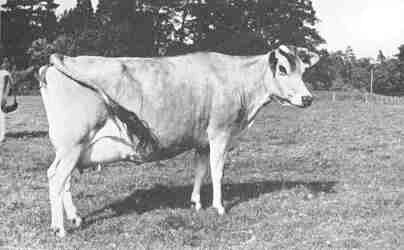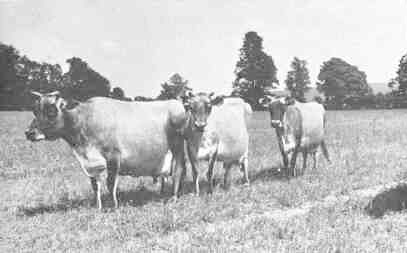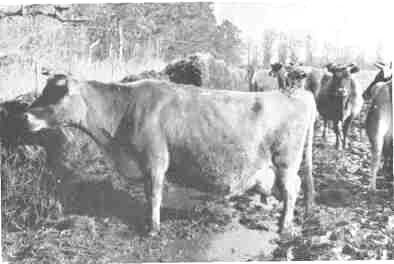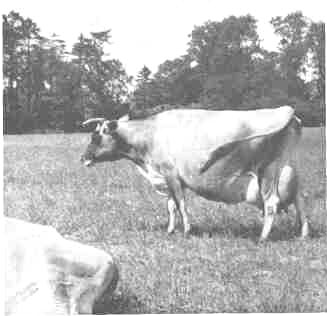
Having demonstrated the establishment and maintenance of productive pastures by organic methods which are available on the farm for every farmer, I want to examine the orthodox efforts to maintain the crop yields upon which our soil chemists and plant breeders have been engaged in the past fifty years.
If you ask any orthodox agronomist what has been the trend of crop yields in the past fifty years, without any reference to statistics he will tell you, without hesitation, that yields have been going up and up. If he is a plant breeder or botanist he knows that tremendous advances have been made in the breeding and selection of heavy yielding varieties and strains. He knows the immense superiority of modern cereal, grass and clover seeds, compared with the unselected strains of our grandfathers.
If he is a soil chemist he believes that the genius of his chemical peers has taught us how to supply in exact proportions all the elements required to gain maximum yields from the heavy-yielding modern crop varieties. We have learned to correct all soil deficiencies and to take advantage of weather conditions by applying chemical stimulants at the right time. We have learned to control crop diseases and pests; and with modern machinery we can do the work so much quicker, making us less subject to climatic vagaries.

20. All her life on mother's milk, silage and grazing only. Now, calving in with her second calf Polden Golden Sunset is yielding 48 lb. daily yield with 1 lb. per gallon of dredge corn and Natural Mineral Mixture

21. Three matrons in the Polden herd: Haughty Hetty, Springtime and Dolly Daydream, who have lived all their lives on herbal leys and silage made from these leys. Note the capacious bellies

22. Polden Haughty Hetty at the peak of a 1,300 gallon 5.76% lactation on self-service silage and kale—at eleven years old

23. Polden Haughty Hetty—showing her condition in the spring following the above winter photograph; recently calved. 'Steamed up' only on fertility pastures she was giving, when this photo was taken, 72 lbs daily, twice milking, at 11-1/2 years old
In other words, without need to make a check on statistics it should be safe to assume that there have been colossal increases in the productivity of all our crops—according to the orthodox expert of to-day.
But an examination of crop records and statistics shows that such opinions are but wishful thinking. For, without the work of selecting and breeding leafy strains of grasses and clovers, and the heavy-yielding disease-resistant strains of wheat, by men like Sir Albert Howard and Sir George Stapledon and the plant-breeding stations of the world, there would have been a serious and rapid decline in yields during the past century. If we are to accept the claims that improved varieties are so vastly superior in yield and disease-resistance, to the varieties commonly in use 50-100 years ago, it becomes evident from official statistics that the immense and increasing use of chemical fertilizers has in fact had a depressing effect on average yields of practically all crops. For all that improved varieties have been able to do, is barely to maintain the recorded yields of fifty years ago—with only infinitesimal increases, which are in any case only to be expected from improved cultivations and harvesting techniques, from a few crops.
Examine the table of officially-recorded yields on page 114. Consider the yields in recent years with the fertilizer expenditure 'needed', or at any rate used, to achieve them. We have glibly gone on accepting and believing the oft-repeated argument that science is mastering mother nature, improving on nature, and forcing the earth to yield tenfold and a hundredfold—or modestly to make two blades of grass grow where one grew before, and other such propaganda for the rape of the earth.
This book is concerned mainly with pastures. How does the chemist explain his failure to maintain the yields of ley pastures compared with the average of the years 1903-12? In the years 1903-12 little, if any chemical fertilizers were used on grassland. To achieve an average yield of just about the same as our grandfathers did, we spent in Britain an average of £10 million a year on chemically dressing our pastures (i.e. one-sixth of the annual expenditure of £61 million from figures on June 4th return, 1953 which showed one-sixth of total crops down to temporary pastures). The average yield of leys in 1903-12 was 29.5 cwt. an acre—with virtually no fertilizers; the average yield in the years 1939-53, when the science of ley farming and government pressure for the development of ley farming was at its highest peak, the average yield was only 29.41 cwt. an acre.
| Crop | Unit | Great Britain (i) |
United Kingdom (ii) |
United Kingdom |
United Kingdom |
United Kingdom |
United Kingdom |
United Kingdom |
Kingdom |
| 10-year average 1903-12 |
10-year average 1939-48 |
1949 (iii) |
1950 (iii) |
1951 (iii) |
1952 (iii) |
1953 (iv) |
average 1939-53 |
||
| Wheat | cwt. | 17.7 | 18.9 | 22.5 | 21.0 | 21.7 | 22.7 | 24.0 | 21.64 |
| Barley | cwt | 16.6 | 17.7 | 20.7 | 19.2 | 20.3 | 20.5 | 22.7 | 19.19 |
| Oats | cwt | 15.4 | 16.7 | 18.4 | 17.3 | 18.3 | 19.2 | 19.8 | 17.65 |
| Potatoes | tons | 6.1 | 7.0 | 6.9 | 7.7 | 7.9 | 7.9 | 8.4 | 7.38 |
| Turnips/Swedes | tons | 14.1 | 14.5 | 14.3 | 15.4 | 16.7 | 16.4 | 18.3 | 15.35 |
| Mangolds | tons | 19.4 | 19.4 | 19.5 | 23.7 | 23.2 | 21.5 | 25.6 | 21.05 |
| Seeds Hay (Temporary Leys) |
cwt | 29.5 | 28.3 | 29.9 | 28.8 | 30.5 | 21.5 | 31.9 | 29.41 |
| Pasture Hay (Permanent Pastures) |
cwt | 23.7 | 20.8 | 21.2 | 21.2 | 22.0 | 22.8 | 23.5 | 21.47 |
(i) Calculated from Annual Abstract of Statistics No. 65. H.M.S.O.
(ii) AgriculturalStatistics, 1949-50 (1952), H.M.S.O.
(iii) Annual Abstract of Stastics No. 90. H.M.S.O.
(iv) Calculated from Monthly Digest of Statistics, No. 98. H.M.S.O.
Fertilizer years (July 1st -- June 30th)
1949-50
1950-51
1951-52
1952-53
1953-54
A. Straight fertilizers:
£
£
£
£
£
Sulphate of ammonia
2,070,800
2,558,500
2,603,500
2,986,900
2,755,800
Other nitrogenous
2,995,300
3,867,700
4,672,200
6,090,300
6,707,400
Superphosphate
2,489,600
2,075,500
2,810,500
5,065,200
4,537,000
Ground rock phos.
597,200
701,500
623,500
1,042,500
852,100
Basic slag
2,687,100
4,176,000
3,370,000
5,005,800
4,412,600
Other phosphates
171,700
330,800
771,500
1,918,500
2,524,500
Potash
1,092,000
962,800
907,900
1,169,500
917,700
B. Compound fertilizers
24,035,600
31,570,100
30,207,500
38,047,800
38,328,000
Total
36,139,300
46,242,600
45,996,600
62,145,500
61,035,100
Notes.--(1) Expenditure has been calculated from returns of total fertilizer deliveries by manufacturers and importers, collected by the Ministry of Agrigulture. (2) For 1949-50 and 1950-51, the subsidized (net) expenditure is shown, but for the remaining years no account is taken of subsidy refunds paid to farmers.
The fall in permanent pasture yield of 1949-53, alongside the minute rise in temporary ley yield during the same period, assuming that both receive fertilizers (which is a reasonable assumption) would seem to indicate that in spite of—or perhaps you may well say because of chemical stimulus—the permanent pasture yields have fallen—whereas the temporary ley, by virtue of its improved strains of leafy grass and clover, has gained in the years 1949-53 a slight increase, in spite of chemical manures and poison sprays.
Monthly Digest of Statistics No. 94, October 1953, H.M.S.O.
30th June, 1953 in
thousand tons
(N)
Acid
(P2O5)
K2O
consumption in
thousand
tons
1949
185
419
196
800
1950
213
461
234
908
1951
211
427
226
864
1952
182
275
170
627
1953
210
400
211
821
The latest figure for 1953 shows a consumption of 800 thousand tons, costing the farmer £61,000,000 a year. Amounts spent on various chemical fertilizers in each of the years 1949-54 are shown in the official table on page 115. As a statement of the immense cost to British agriculture, considered by the orthodox authorities to be essential for the maintenance of the yields set out in the table on page 114, it makes interesting reading; especially when considered against my demonstration that every penny of it can be saved by the methods advocated in my books.
The sceptic, especially one with an interest in selling chemicals or a prejudice in their favour, will point out that the reason why average yields have so little increased is that farmers still do not use enough fertilizers; that though some are securing more than these average yields (I have no difficulty, on poor land, in beating all those figures with no fertilizers at all), others mask the increase by gaining less than they would if they spent more.
This merely shows that some yields must be greatly below those of the good farmers of the years 1903 to 1912, to pull down yields of two to even three and a half tons of wheat to the low average of only 24 cwt. an acre in 1953, and to remove the credit which is due to the skill of the plant breeder; the quality of the land and its distribution would of course remain unchanged in these comparisons throughout the years covered. We may, of course, now be growing more wheat on poor land; but it is amazing to find that our yields of seeds-hay have increased so very little since 1912, and, taking the average for the years 1939-53, they have actually fallen, with all the work of Sir George Stapledon and Aberystwyth added. It is even more remarkable that in 1950, when farmers used the greatest amount of nitrogenous fertilizers in history, they produced less good hay than in 1952, when we used roughly 180,000 fewer tons of these fertilizers. For weather conditions showed no appreciable influence on the yields of either of these two years.
The fact is, that figures of fertilizer consumption measure not the increasing fertility of our land (those who take over a farm will know how short a time established farming custom expects fertilizers to stay in the land) but the size of the dose the soil is expected to swallow, and the bill agriculture has to pay. The return in yields, apart from any consideration of quality, is a very poor average increase for the immense amount of money spent by farmers who can ill afford it, and who, if they did more careful costings, would realize what little return they get from wasting their money in this way.
We can begin to call ourselves farmers when we learn to practice husbandry instead of banditry; when we learn to utilize the free fertility laid at our feet by a benevolent providence, instead of deliberately destroying our resources and relying on the manufacturing chemist to save us. All he can do in the long run, for that is the sole reason for the existence of any commercial undertaking of the financial magnitude of most chemical combines, is to pay dividends to the shareholders (in which your government has some financial interest too, by way of income tax and profits' tax). And those dividends and taxes come out of your future soil fertility. When that is ruined and you are bankrupt, some other fool will come along and buy the latest chemical to 'restore' the soil structure that the same manufacturers' chemical fertilizer or poison spray has destroyed.
Already we have seen the first of these 'soil conditioners' openly admitted by its inventor to be designed to correct the damage caused by the excessive use of his own firm's chemical fertilizers!
And it will still be easier for governments to collect income tax from directors' salaries, from shareholders' interest taxed at source, and profits' tax on the millions of profits made by the chemical combines, than from the farmer's precarious bank overdraft (even that only granted to an infinitesimal proportion of the value of the farmer's few cows and pigs).
This book is not the place to argue the case against government policy or chemical combines. But it is interesting to compare the balance sheet of the farming community with that of the chemical industry, and then ask why it should be necessary for the taxpayer to subsidize the price of chemical fertilizers. It can hardly be claimed that the price of chemicals cannot be reduced while such vast profits are made on their sale to the farmer.
The process whereby chemical combines are able to use governments as their chief salesmen is ever a mystery to the farmer, who is immediately condemned as inefficient if he is unable to sell his produce below cost of production.
It is extremely difficult for the taxpayer to obtain the facts on agricultural subsidies, or to think straight about them; but it is clear that the subsidy on fertilizers is not paid to farmers but to chemical manufacturers.
To the farmer, who is being ever more tightly squeezed between falling produce-prices and rising wages and other costs, the solution is now simple; he can learn to do without this expensive and fortunately unnecessary item of his budget by adapting his farming to make use, instead, of the free processes of nature, which have hitherto largely been neglected, but which this book seeks to describe in a practical way.
NEXT